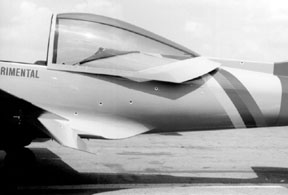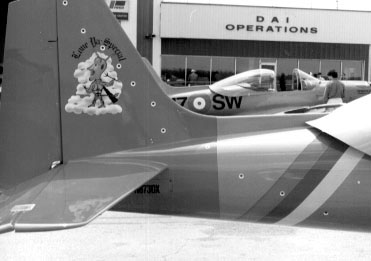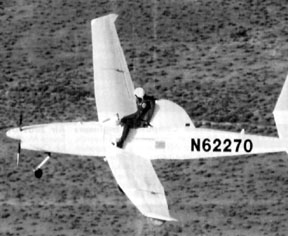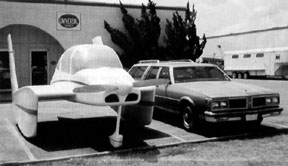World's Fastest Falco. Move over, Karl Hansen --
Guido Zuccoli and company seem to have you beat. The funny thing
is that they're not speed freaks at all; they just built a nice
Falco. The numbers? As part of the Australian CAA first-of-type
approval, their flight tests reveal that at full power and 7500
feet, the Falco's top speed exceeds 202 knots. That's 232 mph,
or 4 mph faster than Karl Hansen's fastest test run. |
| Wood Is Better
Than Plastic. You knew it all along, but here's proof: USA
Today reports that two scientists at the University of Wisconsin
have discovered wood cutting boards have a surprise advantage
over plastic ones. For years, experts have thought that bacteria
might soak into a wood board and contaminate other foods cut
on it. Instead, for the most common bacteria that cause food
poisoning, salmonella, listeria and E. coli, the scientists found
that three minutes after contamination, 99.9% of the bacteria
on wood had disappeared and was presumed dead, but none of the
bacteria on the plastic died. Also that the bacteria increased
on plastic boards kept overnight at room temperature, while none
could be found on wood. The scientists say they have no idea
why this happens. |
Winging It. Public relations consultants and defense
lawyers might want to offer a bit of coaching to Stoddard-Hamilton's
Ted Setzer. Explaining to The Aviation Consumer why they
began shipping a new stretched tail with expanded c.g. limits
in 1989 but didn't get around to flying a Glasair II-S prototype
until a year later, Setzer is quoted as saying, "Unfortunately,
we didn't have the luxury of testing the new tail before we put
it on the market. We had to stay in business. We had to keep
selling kits." Whoo-eeee! |
| Pandering in our
time. The March issue of Sport Aviation explains that
the mandatory Glasair II-S wing/tail modification as being "for
those of you who insist on carrying your gold bullion along for
cross-country flights." |
Soak the rich businessmen. Slick Willie looks positively
generous when compared to the Italians. Italian business aircraft
which are not commercially operated are subject to a state tax,
which has just been raised by 400 per cent. Italy has always
been at the vanguard of taking government programs into the realm
of the absurd, and this tax sets a new standard for insanity
that other nations can only hope to achieve. The tax is based
on aircraft weight, taking no consideration of its age or market
value. As a result, the annual tax on an old Bonanza can be higher
than its current market value, and the tax on a Falcon 50 will
rise from $140,000 last year to almost $700,000 this year. This
is in a country, by the way, that has an official minimum wage
of $100 an hour but which still seems to operate. |
| Hot mike redux.
A pilot approaching Dusseldorf was surprised to hear a female
voice broadcast, "Darling, if you'll add another 100 marks,
I'll spoil you from top to bottom." Apparently a local brothel
owner was using a walkie-talkie tuned to the Dusseldorf frequency
to check that the girls weren't cheating on their fees! |
Criminalizing mistakes. British Airways captain
Glen Stewart had an unblemished 35-year flying career of 14,000
incident-free hours when his Boeing 747 had to go around following
an instrument approach to Heathrow after a flight from Brisbane.
That was in 1989, since then the British CAA brought criminal
charges for allegedly "negligently endangering his Boeing
747 and its passengers." Although widely decried as inappropriate,
this lamentable affair came to an end in December when Captain
Glen Stewart's body was found in a car near the Old Course at
St. Andrews in Scotland. A hose pipe led from the exhaust into
the car. Way to go, guys. If you need any more help, we've got
this Walsh fellow in Washington we can lend you. |
| How do you do.
British writer Geoffrey Jones has written an encyclopedic work
on homebuilt aircraft. "The Complete Book of Building &
Flying Your Own Plane" is a heavily illustrated 288-page
tome covering the gamut of homebuilt airplanes. There's some
refreshing coverage of the realities of rolling your own with
particular focus on Neville Langrick's Falco project. Available
for £20 from Patrick Stephens, Ltd., Sparkford, Nr Yeovil,
Somerset BA227JJ, U.K. or for $39.95 plus $4.50 S&H from
Zenith Books, P.O. Box 1, 729 Prospect Avenue, Osceola, WI 54020. |
 
It's always a good idea to remember that not everyone appreciates
low-flying aircraft. |
| Kas is Back. Kas
Thomas began life playing with roller tappets and nursing the
sparkplug of a radial engine jug so he thinks his mother is a
Pratt & Whitney R-985. He subsequently became aviation's
funniest, most outrageous and most capable hardware technophile,
started Light Plane Maintenance and edited it for years.
Burned out, he took a sabbatical but now he's back in town with
his keyboard a-blazing. First there's a book, Fly the Engine is a 224-page book on the who-what-when-where-and-how's of operating
aircraft engines. He's also got a newsletter, TBO Advisor,
which is entirely devoted to engines and their care and feeding. Fly the Engine is $29.95 plus shipping and TBO Advisor is $45 a year for six issues. You might as well order both from
TBO Advisor, Box 625, Old Greenwich, CT 06870 -- telephone (203)
967-8260 or (800) 484-1027, ext 3752. Or visit the TBO
Advisor website. |
Sacramento Sky Ranch's John Schwaner was separated
at birth from Kas (an overhauler 'parted out' the engine and
babies) and he too continues to pump out books on engines. Many
of you have already read his Sky Ranch Engineering Manual which is still available for $19.95. Now there's a new book The
Magneto Ignition System, which just possibly may tell you more
than you wanted to know, but it's only $10.95. Order either or
both from Sacramento Sky Ranch, Box 22610, Sacramento, CA 95822-telephone
(916) 421-7672 or (800) 433-3564. |
| Hedge Darter.
If God had meant milking stools to fly, after flying a Venture
God would change His mind. A friend of mine recently took a ride
in a Questair Venture and the owner reported that of 21 flying,
20 have encountered difficulties on the runway and have suffered
sheet metal damage. |
Truth in Advertising. The recent brouhaha on kitplane
stability problems got some of us a-thinking of advertising headlines
for the kitplanes of the future that might have just a few design
problems. Here are a few samples: "Instability by Design",
"The Relentless Pursuit of Mediocrity", "We Never
Said It Would Fly", "Cheap Airplanes for Cheap Lives",
"Bite the Dust in Our New CloudDuster", "More
than 98% of Our Kits Sold in the Last 10 Years Are Still in the
Shop", "It Just Feels Wrong", "Just for the
Kill of It", "We Bring Bad Things to Flight",
"Quality is Job 15", "The Other White Airplane",
"This Dud's for You", "The Great White Dope",
and "We Fly Harder". |
| CAD/CAM Cam Fandango.
Pity the owners of freshly overhauled parallel-valve Lycomings
(320 and 180 hp 360 series) who are flying with Superior P/N
SL18840 cams. They're flying with cams that open and close all
valves six degrees late, which isn't going to help the power.
Superior admits the mistake but hasn't recalled them because
the engine power is still within the factory tolerance. How did
it happen? Best guess is that it's a drafting error on the CAD
system. Because the cam turns at twice crankshaft speed, it's
only a three-degree error at the lobe. The first lobe is at 1-1/2
degrees and then all other lobes are dimensioned from it. Thus,
it looks like the CAD operator entered the first lobe in the
wrong direction, thus creating a three-degree lobe error. Appropriately,
it was Lycoming's redfaced Mr. Boob who reported the lobe error. |
It can happen to anybody. Considering doing your
own first flight, despite warnings and advice to get an experienced
pilot? Wolfgang Herbst was the director of advanced design and
technology of the Military Aircraft Division of MBB in Munich.
Prior to that, he was a senior group engineer on the F-15 program
for McDonnell Douglas, and also manager of V/STOL programs with
VFW Co. in Bremen, Germany. The author of numerous technical
articles and papers dealing with preliminary aircraft design,
aerodynamics and maneuverability, Herbst died while flight testing
his homebuilt replica of the FW-190 WWII fighter. |
| Leaving on good
terms. Michael Maya Charles, longtime contributing writer to Flying, recently put out a press release that he was resigning
from the magazine. |
Is nothing sacred? Fie upon Robert Hughes, reed
and bagpiper maker in Newry, Northern Ireland, and his helper
Roy Crawford, an engineer at Queen's University in Belfast. Lignocellulosiphiles
will be distraut to hear that Hughes and Crawford are developing
a bagpipe reed made of polycarbonate. "Reed making hasn't
changed at all in the last 500 years", says Hughes, who's
also working on plastic reeds for the Irish uilleann pipes and
other woodwind instruments such as the saxophone. What's next-composite
cellos, fiberglass banjos, ceramic violins, and acrylic pianos? |

Ride 'em, Cowboy. The latest techniques in test piloting are
demonstrated by Mike Melville on the first flight of the Rutan
Raptor/Talon unmanned aerial vehicle. The 66-ft wingspan Raptor/Talon
is powered by a Rotax 912 with two-stage turbochargers and is
expected to operate at 65,000 to 70,000 feet. This is the second
recent Rutan design with the engine on the front, tail on the
rear and completely without canards. Gee, if he keeps this up,
we'll have to ship him off to Mr. Frati for styling lessons.
Consulting engineers to this project are using our Benchmark
performance testing software to model the behavior of the Raptor/Talon
aircraft at very high altitudes.
|
Guido Zuccoli reports that the Australian authorities
have completed the 'first of type' approval process on the Falco
and the Falco is now an approved design for construction in Australia.
Unlike some other kitplanes, the Falco has no retrictions imposed
on it because of stability problems. There was only one 'glitch'
in the flight testing, as the pilot found Falco VH-LZF had a
problem with 'aileron snatch' in the clean power-off stall tests,
probably caused by a slight error in wing twist and which was
cured by the addition of a stall strip on the right wing. |
| 'Ferrari' no more.
Now the Falco is the 'Alfa of the air', according to "Flight
of the Falco", an article by our own Steve Wilkinson in
the Summer 1993 issue of Il Quadrifoglio, a glossy quarterly
published by Alfa-Romeo. There's a nice touch in the article
as Steve mentions that Don Black, chief engineer for Alfa-Romeo
in the U.S., gave me invaluable assistance by interpreting the
original Italian drawings with their arcane dimensioning, tolerancing
and material specifications. |
Three times and you're out. John Rawlings seems
to have attracted more bad luck than any other Falco builder.
John lives in St. Charles, Missouri, right down on the big river,
and his Falco project was nearly destroyed in 1986 when a flood
submerged the airplane. All of the wood parts were ruined, and
it took him two years to recover from the flood. Now it has all
happened again. His project was at the Creve Coeur airport, and
even though he had the Falco suspended 14 feet from the floor
with pulleys and ropes, the water rose even higher. The Falco
spent seven and a half weeks under water, and John found it on
the floor with 16 inches of incredibly dense mud covering and
filling everything. John has finally given up on the airport
but not the Falco. He's moving the project to a warehouse on
high ground. John is a retired McDonnell Douglas tool maker,
and as he talked about getting the project rolling again, I asked,
"John, how old are you?" "I'm going to make it,"
he said. "I'm going to fly that son-of-a-bitch when I'm
ninety-four." |
| FAA wakes up to
GPS. FAA Adminstrator Joe Del Balzo recently said that pilots
will soon be able to use GPS as a secondary means of navigation
and that it could be approved as a primary navigation source
for commercial and general aviation within two years. This is
a dramatic and welcome reversal of policy, and it comes as all
of aviation is embracing GPS with a passion. It was only two
years ago that Sony introduced its hand-held GPS. Last year,
three companies had hand-held GPS units with an aviation database.
This year at Oshkosh, there were several hand-held GPS models
with moving map displays. |
These hostile shores. Why customs would be interested
in FAA-business paperwork is beyond me, but for the lack of a
signature on an otherwise perfectly filled-out Form 337 for the
temporary installation of a ferry tank in a TB-20 Trinidad, aviation
writer and ferry pilot Peter Lert was detained for the day, then
placed in the Penobscot County Jail overnight, had the airplane
seized, along with all of his personal equipment, records and
passport. At one point, Lert was being threatened with a maximum
penalty of $250,000 and/or up to three years in prison. He had
to hire two attorneys to get him out of the predicament. In the
end, he was fined heavily after paying tens of thousands of dollars
in legal fees. The irony is that Lert's parents emigrated from
Germany in the 1930s largely to escape a society in which arbitary
and unreasonable prosecution was becoming commonplace. |

According to Aviation Week, the Sky Car will be powered
by either a 475-hp automobile racing engine or two turboprop
engines.
|
A piddling matter. Pity Lt. Col. Don Snelgrove
who lost control of his F-16 jet fighter over the no-fly zone
in northern Iraq in September. On a four-hour mission, Snelgrove
tried to use the regulation plastic container and dehydrated
sponge, popularly knows as a 'piddle pack'. After he took off
his lap belt, it caught between the seat and the sidestick, sending
the plane into a spin. The pilot struggled to regain control
of the plane and finally bailed out of the $12-million fighter
at 2,000 feet. Rules for the use of 'comfort stations' in the
fighters have now been amended: lap-straps are loosened, not
unfastened. |
| Cheap trainers.
Stelio Wilkinson reports: As you may know, the USAF has chosen
the British Slingsby two-seater as its new flight-screening aircraft,
the mission that used to be fulfilled by modified Cessna Skyhawks
("Mescaleros," they called them). The mission basically
is to let potential pilot candidates fly around so you can find
out early if they're prone to barf or are terrified of stalls,
etc. The Slingsbys will be assembled by Northrop and called the
Slingsby/Northrop T-3As, thereby making them "American airplanes."
The thing looks like an incredibly awkward Falco with fixed gear
and a 260-hp Lycoming. What is most interesting, however, is
that the government has ordered 113 (potential maximum order)
of these turkeys, which will be entering line service next month,
at a price that works out to $486,725 apiece. Granted,
that probably includes some spares and support, but what we're
talking about here is a two-place, fixed-gear, utterly conventional
airplane with an off-the-shelf 260-hp Lycoming engine. Sheesh. |
Winged that thang. The ultralight pilot was cruising
along the mountain ridges in West Virginia when he decided to
explore a valley that went way up into the hills. As he neared
the end of the valley, a mountain man and his wife saw the craft
skimming over the hills. "Great God, Bess! Look at that
thing a-coming." The man grabbed his shotgun and went running
down the mountain after it. His wife heard two shots, and then
the man ran back up to the cabin, all excited. "What was
it? Did you get it?", she asked. "Well, I don't know
what it is, and I didn't get it, but I did make it drop that
man it was carrying." |
According to an FAA review of accidents, while other classes
of general aviation aircraft have experienced dramatic improvements
in the number of accidents and accident rates, the number of
homebuilt accidents rose 25% in 1992, and a much higher share
of homebuilt accidents are fatal-32.6% vs 18.8% for the rest
of general aviation. The review concludes that although the majority
of homebuilt aircraft pilots have good safety records, lower
time pilots and pilots with little or no experience in homebuilt
aircraft had significantly more accidents. Also, 14% of homebuilt
accidents occurred on the pilot's first flight in the aircraft
and 5% on the second flight. In all, 24% of the accidents occurred
during the takeoff or landing phases due to inadvertent stalls,
rolls or veering off the runway. Inflight breakups and structural
failures accounted for 6% of the accidents. In short, 40 to 50%
of the accidents in homebuilt aircraft seem to indicate a lack
of familiarity with the flight characteristics of the aircraft,
and this is a much higher rate than for other classes of general
aviation aircraft.
The review identified apparent airworthiness problems in 16%
of the accidents. Most of these were related to the builder/pilot
making modifications to the aircraft. Seven percent of homebuilt
accidents were simply from running out of fuel, while another
5% involved contaminated fuel or blocked fuel lines due to poor
maintenance or inappropriate parts. Sixteen percent of homebuilt
accidents are directly related to obvious airworthiness issues.
The report concludes that everyone involved in aviation should
attempt to reach people new to homebuilt aircraft with a somewhat
aggressive but not very complex message: learn the characteristics
of your aircraft, and recognize that meeting design specifications
is critical.
|
Where are the military Frati's? Steve Wilkinson
compiled the following list of countries that operate Iron Falcos
(SF.260s). In ascending order of number owned, they are: Brunei
(2), Uganda (2), Bolivia (3), Chad (3), Dubai (5), Haiti (5),
Nicaragua (5), Burundi (7), Ireland (7), Zambia (8), Zaire (9),
Burkina Faso (11), Ecuador (12), Ethiopia (12), Thailand (12),
Sri Lanka (17), Singapore (26), Zimbabwe (30), Philippines (35+),
Belgium (36), Italy (38), Turkey (40), and finally Libya (190).
Thus the world's leading Frati enthusiast is Mumaar Quadaffi,
who owns more SF.260s than Frank Strickler has ever seen. Because
he's so wild about these machines, we've decided to send a personal
invitation to Col. Quadaffi for the next Oyster Fly-In and ask
him to bring his favorite Frati. |
 
|
![]()